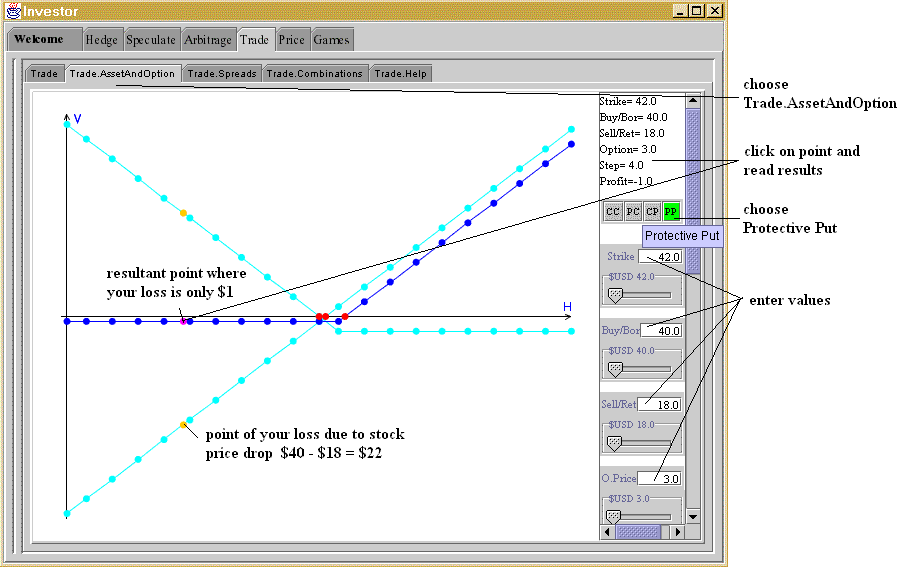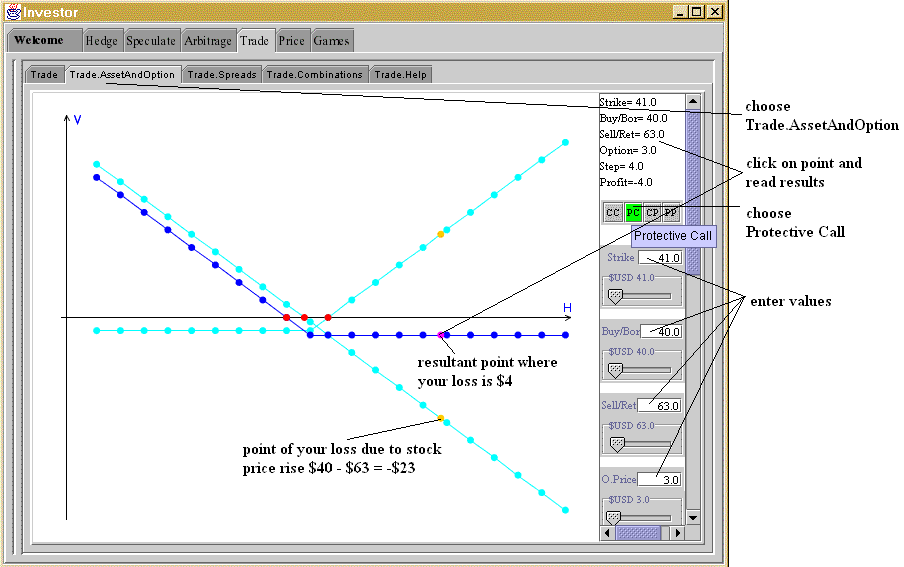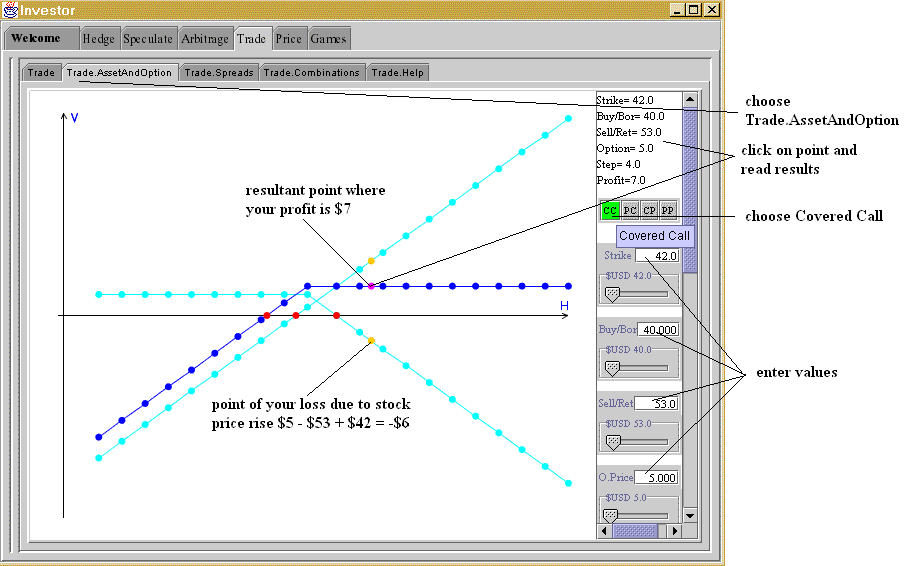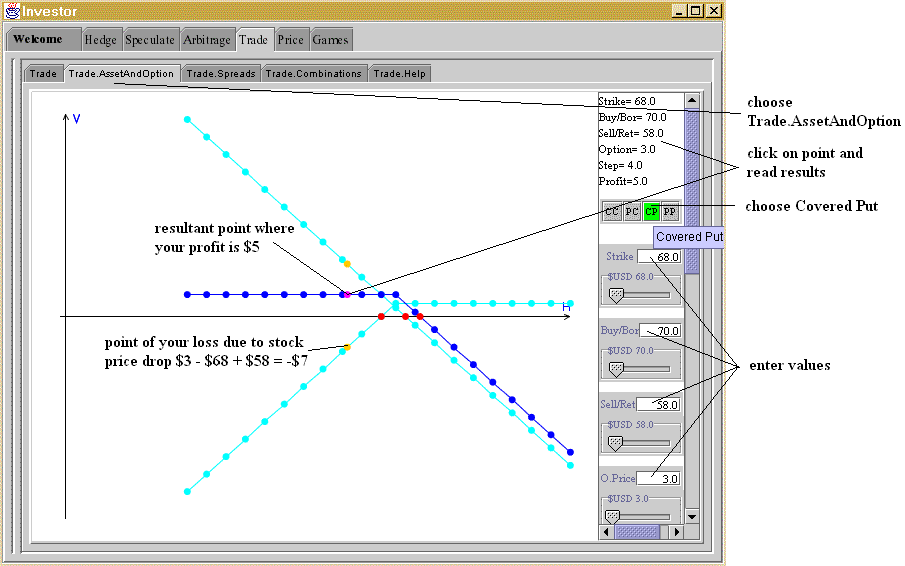

or $22/$40*100% = 55% of initial investment. But if you buy Put option with strike $42 on this stock (Protective Put strategy), after stock price drop you sell your stock for $42 (by exercising Put option) and your gain is
or taking in account the $3 you paid for the Put option your loss is
which is only $1/$40*100% = 2.5% of initial investment.
Not bad, 2.5% loss instead of 55% loss!
This case in Investor is shown on the picture below

Another method that is called Protective Call is used in case when you want to protect your short asset. Short asset is an asset that you borrow. For example, let's say you borrowed the XYZ company stock and sold it in the market. If price of this stock goes up, you have to pay higher price to purchase it to return back to party you borrowed it from. To protect yourself from this rise of the stock price you buy Call Option. Taking the short position in underlying position (in your example stock) and buying Call option (Long Call) is called Protective Call strategy. The Call option protects you from rise of stock price. For example if your stock price was $40 when you borrowed and sold it in the market and stock price goes up and is $63 by the time you have to return it back, then after you buy back the stock and return it your loss is
or $23/$40*100% = 57.5% of initial stock price. But if you initially buy Call Option on this stock (Protective Call strategy) with strike of $41, by the stock return time you can buy it in the market for $41 (by exercising the Call option) instead of market price $63, return it back and your loss is
or taking in account the $3 you paid for the Call option your loss is
or $4/$40*100% = 10% of initial stock price.
Again, we have 10% loss instead of 57.5% loss!
This case in Investor is shown below

Other method called Covered Call is used to protect you from sharp rise of underlying asset price when you hold short position in Call option (Short Call or Written Call). For example if you wrote the Call option on XYZ stock and the price of this stock rises, then you have to pay this high price for the stock in the market to fulfill your obligation (you have to buy it for higher price than the strike price which you sell it for under your obligation). To protect yourself from this loss, you could initially buy the stock XYZ itself (take Long position in underlying stock) and by the option expiration time you won't have to buy it in the market for higher price. Let's consider example when you have written Call option on XYZ stock with strike $42. You've sold Call option for $5 and price of stock is $40. Suppose at option expiration time stock price rises to $53. After you buy this stock in the market for $53 and sell it for $42 (according to your written Call) your loss is
Taking in account $5 you got when you initially sold the option your loss is
or $6/$40*100% = 15% of initial stock price. But if you initially (by the time you wrote Call option) had bought the underlying XYZ stock (used Covered Call strategy) for $40, then by the option expiration time you would deliver it for $42 (according to your written Call) and your gain would be
or $7/$40*100% = 17.5% of initial stock price.
See, we have 17.5% profit instead of 15% loss! Much more then just protection from loss!
This case in Investor is shown below

Method called Covered Put is used to protect you from fall of underlying asset price when you hold short position in Put option (Short Put or Written Put). For example if you wrote the Put option on XYZ stock and the price of this stock goes down, then to fulfill your obligation you have to buy the stock that costs less in the market paying higher price for it (you pay strike price that is more than the stock price in the market). To protect yourself from this loss, you could initially borrow the underlying stock XYZ (take Short position in underlying stock), sell it in the market immediately and use obtained money to fulfill your obligation by the option expiration time (buy the stock paying the strike price). Let's consider example when you have written Put option on XYZ stock with strike $68. You've sold Put option for $3 and price of stock is $70. Suppose at option expiration time stock price falls to $58. By the option expiration time, after you buy this stock for $68 to fulfill your obligation (according to your written Put), sell it in the market for market price $58, your loss is
Taking in account $3 you got when you initially sold the option your loss is
or $7/$70*100% = 10% of initial stock price. But if you initially (by the time you wrote Put option) had borrowed the underlying XYZ stock (used Covered Put strategy) and sold it immediately in the market for $70, then by the option expiration time, to fulfill your obligation, you would buy it for $68 (according to your written Put) and your gain would be
or $5/$70*100% = 7.14% of initial stock price.
We have 7.14% profit instead of 10% loss!
This case in Investor is shown below
